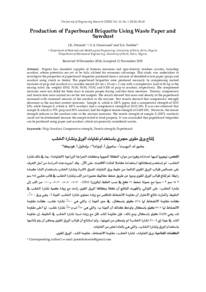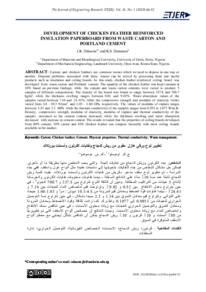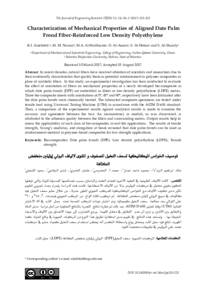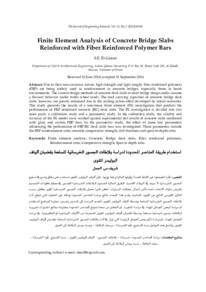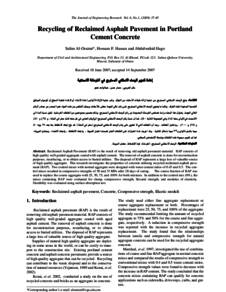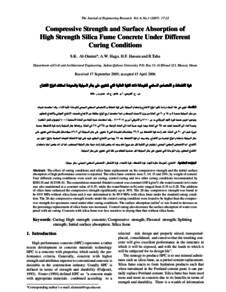وثيقة
Production of paperboard briquette using waste paper and sawdust.
المساهمون
Onowuma, S. A., مؤلف
Fodeke, E. A., مؤلف
الناشر
Sultan Qaboos University.
ميلادي
2016
اللغة
الأنجليزية
الملخص الإنجليزي
Nigeria has abundant supplies of biomass resources and agro-forestry residues (waste), including sawdust, whose potentials are yet to be fully utilized for economic advantage. This study was undertaken to investigate the properties of paperboard briquettes produced from a mixture of shredded waste paper (pulp) and sawdust using starch as binder. The paperboard briquettes were produced manually by compressing soaked mixtures of pulp and sawdust in a wooden mould (28 cm x 28 cm x 1 cm) with a compressive load of 26 kg in the mixing ratios (by weight) 100:0, 70:30, 50:50, 70:30, and 0:100 of pulp to sawdust, respectively. The compressed mixtures were sun dried for three days to ensure proper drying and free from moisture. Density, compressive and tensile tests were carried out on the test samples. The results showed that mass and density of the paperboard increased with increased amount of the sawdust in the mixture. Test results showed that compressive strength decreases as the sawdust content increases. Sample A, which is 100% paper, had a compressive strength of 5215 kPa, while Sample E, which is 100% sawdust, had a compressive strength of 22.02 kPa. It was also observed that sample B, which is 70% pulp and 30% sawdust, had the highest tensile strength of 0.629 kPa. However, the tensile strength reduces as the sawdust ratio in the mixture increases. The tensile strength of sample E (100% sawdust) could not be determined because the sample failed to bind properly. It was concluded that paperboard briquettes can be produced using paper and sawdust, which are generally considered wastes.
المجموعة
ISSN
1726-6742
URL المصدر
zcustom_txt_2
Odusote, J.K., Onowuma, S.A., & Fodeke, E.A. (2016). Production of paperboard briquette using waste paper and sawdust. The Journal of Engineering Research, 13 (1), 80-88.
الملخص العربي
نيجيريا لديها إمدادات وفيرة من موارد الكتلة الحيوية ومخلفات الحراجة الزراعية ( النفايات)، بما في ذلك نشارة الخشب، لم تستخدم إمكاناتها استخداما كاملا لفائدة الاقتصاد حتى الآن. وقد أجريت هذه الدراسة من أجل التعرف على خصائص قوالب الورق المقوى الناتجة من خليط ورق النفايات الممزق (اللب) ونشارة الخشب باستخدام النشا كمادة رابطة. تم إنتاج قوالب الورق المقوى يدويا عن طريق ضغط مخاليط مغمورة من اللب ونشارة الخشب في قالب خشبي (28 سم * 28 سم * 1 سم) مع حمولة ضغط 26 كغ في نسب الخلط (بالوزن) 100:0، 70:30، 50:50، 70:30، و 0:100 من اللب إلى نشارة الخشب، على التوالي. وأظهرت النتائج أن كتلة وكثافة الورق المقوى زادت مع زيادة كمية نشارة الخشب في الخليط. وأشارت نتائج الاختبار أن مقاومة الانضغاط تتناقص مع زيادة محتوى نشارة الخشب. العينة أ، وهي ورق 100%، كانت مقاومة الانضغاط لها 5215 كيلو باسكال، في حين العينة إ، والتي هي 100% نشارة خشب، كانت مقاومة الانضغاط لها 22.02 كيلو باسكال. ولوحظ كذلك أن العينة ب، والتي هي 70% لب و 30% نشارة خشب، لها أعلى مقاومة شد وهي 0.629 كيلو باسكال. ومع ذلك ، فإن مقاومة الشد تقل مع زيادة نسبة نشارة الخشب في الخليط . إن مقاومة الشد في عينة إي (100% نشارة الخشب) لم يتمكن من تعيينها، وتم استنتاج أن قوالب الورق المقوى يمكن أن يتم إنتاجها باستخدام الورق ونشارة الخشب، والتي هي بالعادة تعتبر من النفايات.
قالب العنصر
مقالات الدوريات

